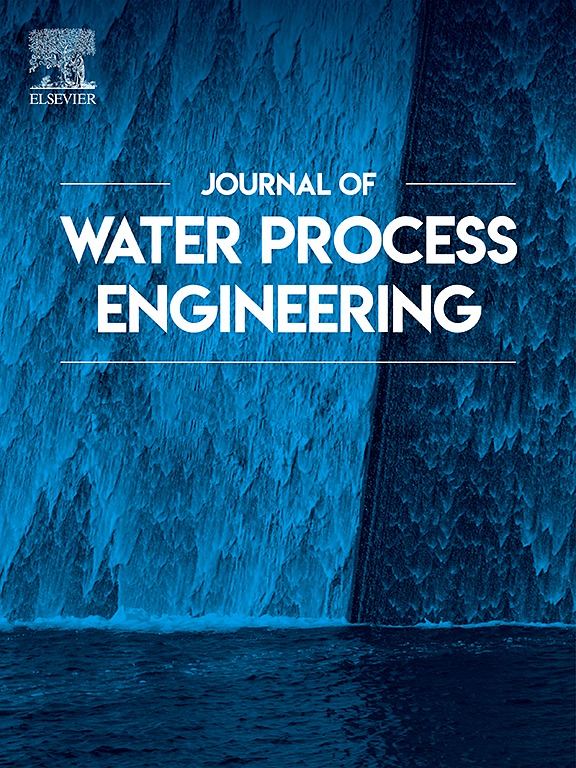Analytical approaches to track nylon 6 microplastic fiber degradation using HKUST-1(Cu/Fe)-derived CuO/TiO2 photocatalyst
IF 6.3
2区 工程技术
Q1 ENGINEERING, CHEMICAL
引用次数: 0
Abstract
Nylon 6 microplastic (MP) degradation was performed for the first time by photocatalysis using HKUST-1(Cu/Fe)-derived CuO/TiO2 (TCFH). The TCFH composites with 5, 10, and 15 wt % of HKUST-1(Cu/Fe) were synthesized using the solvothermal method, followed by calcination, and deposited on borosilicate glass. The prepared materials were analyzed using TGA/DSC, UV–Vis/DRS, PL spectroscopy, XRD, XPS, FTIR, N2 physisorption, and SEM-EDS techniques to confirm their crystallinity, chemical bonding, porosity, thermal, optical, and morphological properties. With an increase in HKUST-1(Cu/Fe) content in TiO2, the crystallite size, surface area, and pore size increased, whereas the bandgap energy and the recombination rate of photogenerated e−/h+ pairs decreased compared to TiO2, favoring nylon 6 MP degradation. The TCFH (15 wt %) displayed optimal MP degradation performance, degrading MPs at pH 7 under UV–Vis light, showing an increase in TOC content during MP degradation (11.42 mg L−1), related to the presence of soluble by-products, a decrease in turbidity associated with the reduction in particle size and MP concentration, and a decrease in amide signal intensity at 3090 cm−1 compared with values observed during photolysis and TiO2 photocatalysis. SEM and XPS analyses confirmed the oxidation and breakage of the MP polymeric chain. Soluble organic compounds such as aldehydes, amides, and carboxylic acids generated during MP degradation were detected by GC–MS. Thus, photocatalysis using the bimetallic MOF HKUST-1(Cu/Fe)-derived CuO/TiO2 is a promising treatment for eliminating polyamide MPs in water effluents, where reactive oxygen species (•OH and O2![]() −) contribute to their degradation.
−) contribute to their degradation.
求助全文
约1分钟内获得全文
求助全文
来源期刊

Journal of water process engineering
Biochemistry, Genetics and Molecular Biology-Biotechnology
CiteScore
10.70
自引率
8.60%
发文量
846
审稿时长
24 days
期刊介绍:
The Journal of Water Process Engineering aims to publish refereed, high-quality research papers with significant novelty and impact in all areas of the engineering of water and wastewater processing . Papers on advanced and novel treatment processes and technologies are particularly welcome. The Journal considers papers in areas such as nanotechnology and biotechnology applications in water, novel oxidation and separation processes, membrane processes (except those for desalination) , catalytic processes for the removal of water contaminants, sustainable processes, water reuse and recycling, water use and wastewater minimization, integrated/hybrid technology, process modeling of water treatment and novel treatment processes. Submissions on the subject of adsorbents, including standard measurements of adsorption kinetics and equilibrium will only be considered if there is a genuine case for novelty and contribution, for example highly novel, sustainable adsorbents and their use: papers on activated carbon-type materials derived from natural matter, or surfactant-modified clays and related minerals, would not fulfil this criterion. The Journal particularly welcomes contributions involving environmentally, economically and socially sustainable technology for water treatment, including those which are energy-efficient, with minimal or no chemical consumption, and capable of water recycling and reuse that minimizes the direct disposal of wastewater to the aquatic environment. Papers that describe novel ideas for solving issues related to water quality and availability are also welcome, as are those that show the transfer of techniques from other disciplines. The Journal will consider papers dealing with processes for various water matrices including drinking water (except desalination), domestic, urban and industrial wastewaters, in addition to their residues. It is expected that the journal will be of particular relevance to chemical and process engineers working in the field. The Journal welcomes Full Text papers, Short Communications, State-of-the-Art Reviews and Letters to Editors and Case Studies
 求助内容:
求助内容: 应助结果提醒方式:
应助结果提醒方式:


